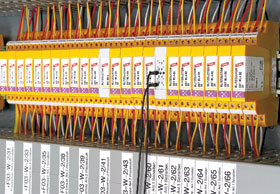

The function of emergency alarm systems is to produce an alarm in the event of danger and to remain passive when there is none. The malfunction of these systems, either no alarm sounding if there is danger, or an alarm sounding unnecessarily, is not just a nuisance; it can also be dangerous and can result in expensive call-out fees.
False alarms have the following consequences:
• Personnel start ignoring the alarm messages.
• Emergency staff is unnecessarily called out.
• The triggering of fire extinguishing systems can cause interruption of operations.
All these factors cause unnecessary costs and can be prevented if possible causes of false alarms are recognised at an early design stage and are eliminated by taking suitable preventive measures. Lightning strikes are one such cause, and given the profusion of summer storms in South Africa, this is a real threat.
Coordinated lightning and surge protection prevents false alarms and increases the availability of the systems.
Many of today’s emergency alarm systems have an increased immunity to transients on the primary lines, secondary lines and mains voltage cables according to IEC 61000-4-5. Nevertheless, only external and internal lightning protection measures provide comprehensive protection against damage resulting from lightning strikes and surges.
Monitoring principles
Different monitoring principles are used for emergency alarm systems:
Pulse polling technology:
• Information from the sensor which has triggered the alarm is digitally transmitted. This allows the identification of the sensor and its exact location.
• DC circuit technology: According to the closed circuit principle, every alarm line is permanently monitored. If a sensor in a line is triggered, the line is interrupted and an alarm is produced in the alarm panel. However, only the alarm line, but not the individual sensor can be identified.
Irrespective of the monitoring principle used, all cables extending between the different areas of the emergency alarm system must be integrated in the lightning and surge protection concept of the overall system.
Recommended protection
Dehn’s Blitzductor XT, type BXT ML2 BE, must be installed to protect two-wire alarm lines and connect the earth drain wire by means of an EMC spring terminal. For cables with more than two wires, a four-wire version, BXT ML4 BE, is available. Surge protective devices are selected according to the voltage of the alarm lines, which is typically between 12 and 48 V. The low internal resistance is also a clear advantage of arresters since the maximum resistances of the alarm lines must not be exceeded. For the outputs of the alarm panels (acoustic and visual) it must be ensured that the nominal current of the surge protective devices is not exceeded.
For more information contact Alexis Barwise, Dehn Protection South Africa, +27 (0)11 704 1487, alexis.barwise@dehn-africa.com, www.dehn-africa.com

© Technews Publishing (Pty) Ltd | All Rights Reserved